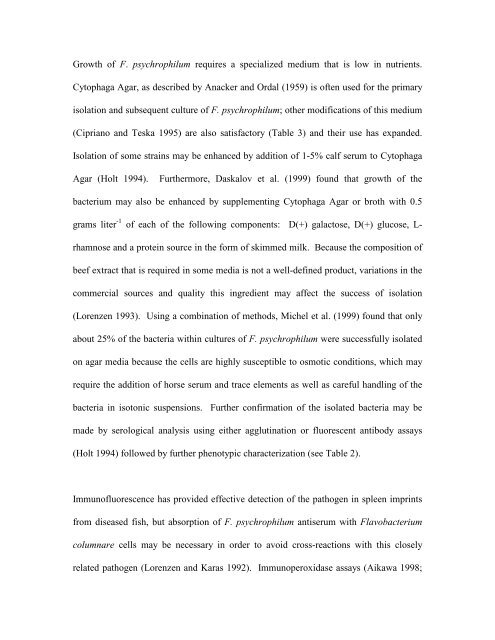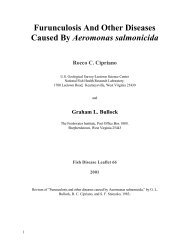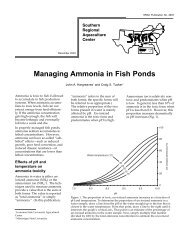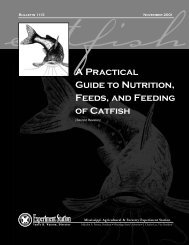Flavobacterium psychrophilum, cause of ... - cop.eXtension.org
Flavobacterium psychrophilum, cause of ... - cop.eXtension.org
Flavobacterium psychrophilum, cause of ... - cop.eXtension.org
You also want an ePaper? Increase the reach of your titles
YUMPU automatically turns print PDFs into web optimized ePapers that Google loves.
Growth <strong>of</strong> F. <strong>psychrophilum</strong> requires a specialized medium that is low in nutrients.<br />
Cytophaga Agar, as described by Anacker and Ordal (1959) is <strong>of</strong>ten used for the primary<br />
isolation and subsequent culture <strong>of</strong> F. <strong>psychrophilum</strong>; other modifications <strong>of</strong> this medium<br />
(Cipriano and Teska 1995) are also satisfactory (Table 3) and their use has expanded.<br />
Isolation <strong>of</strong> some strains may be enhanced by addition <strong>of</strong> 1-5% calf serum to Cytophaga<br />
Agar (Holt 1994). Furthermore, Daskalov et al. (1999) found that growth <strong>of</strong> the<br />
bacterium may also be enhanced by supplementing Cytophaga Agar or broth with 0.5<br />
grams liter -1 <strong>of</strong> each <strong>of</strong> the following components: D(+) galactose, D(+) glucose, L-<br />
rhamnose and a protein source in the form <strong>of</strong> skimmed milk. Be<strong>cause</strong> the composition <strong>of</strong><br />
beef extract that is required in some media is not a well-defined product, variations in the<br />
commercial sources and quality this ingredient may affect the success <strong>of</strong> isolation<br />
(Lorenzen 1993). Using a combination <strong>of</strong> methods, Michel et al. (1999) found that only<br />
about 25% <strong>of</strong> the bacteria within cultures <strong>of</strong> F. <strong>psychrophilum</strong> were successfully isolated<br />
on agar media be<strong>cause</strong> the cells are highly susceptible to osmotic conditions, which may<br />
require the addition <strong>of</strong> horse serum and trace elements as well as careful handling <strong>of</strong> the<br />
bacteria in isotonic suspensions. Further confirmation <strong>of</strong> the isolated bacteria may be<br />
made by serological analysis using either agglutination or fluorescent antibody assays<br />
(Holt 1994) followed by further phenotypic characterization (see Table 2).<br />
Immun<strong>of</strong>luorescence has provided effective detection <strong>of</strong> the pathogen in spleen imprints<br />
from diseased fish, but absorption <strong>of</strong> F. <strong>psychrophilum</strong> antiserum with <strong>Flavobacterium</strong><br />
columnare cells may be necessary in order to avoid cross-reactions with this closely<br />
related pathogen (Lorenzen and Karas 1992). Immunoperoxidase assays (Aikawa 1998;






